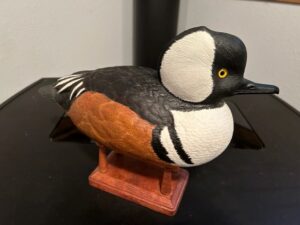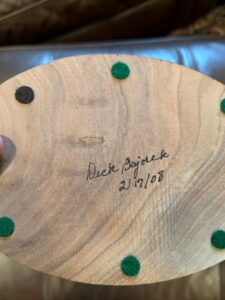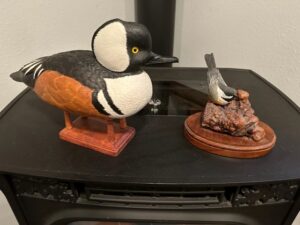A Green Bay Decoy Carver and Carving Instructor
A Decoy Corner Article
Photos & Article by Bruce Urben, WWA President
The vast majority of decoy carvers began their journey in carving through necessity, needing decoys to lure ducks and geese to their gun. Then there are a few that were passionate about wildlife and nature and had the skill to reproduce waterfowl for all to view and enjoy. Richard Bajorek was one of those carvers.
 Richard Bajorek was born on March 15th, 1932 to Joseph and Marie (Rolczynski) Bajorek, and grew up in the Pulaski area with his three brothers. Nature was at Dick’s doorstep and his family was immersed daily in all forms of wildlife. In 1955, Richard married Mary Feller and they had three daughters together. Richard lived the rest of his life in the Green Bay area. He was employed as a millwright for the local Green Bay Carpenters union and was a very skilled carpenter. Richard also taught wood carving for 25 years at the NWTC, technical college in Green Bay. He became a passionate carver of wildlife, a member of the Mid-Wisconsin Chippers carving club and the Northeast Wisconsin woodworking group. Because of his passion, Richard spent a large part of his life teaching others about wood carving and specifically carving very realistic waterfowl, songbirds and fish.
Richard Bajorek was born on March 15th, 1932 to Joseph and Marie (Rolczynski) Bajorek, and grew up in the Pulaski area with his three brothers. Nature was at Dick’s doorstep and his family was immersed daily in all forms of wildlife. In 1955, Richard married Mary Feller and they had three daughters together. Richard lived the rest of his life in the Green Bay area. He was employed as a millwright for the local Green Bay Carpenters union and was a very skilled carpenter. Richard also taught wood carving for 25 years at the NWTC, technical college in Green Bay. He became a passionate carver of wildlife, a member of the Mid-Wisconsin Chippers carving club and the Northeast Wisconsin woodworking group. Because of his passion, Richard spent a large part of his life teaching others about wood carving and specifically carving very realistic waterfowl, songbirds and fish.
I first met Richard in the early 2000’s when I was referred to him as a carver interested in donating his work to conservation groups as fundraisers. I visited him at his home in the Village of Howard on numerous occasions to select a decoy for our annual WWA fundraising banquet, and of course to have a cup of coffee and talk carving with him. His answer each year when I contacted him was to “come to the house and see what I have and what would work well for your banquet.” Dick was very generous in donating his work to WWA, DU and Trout Unlimited.
Dick was a student of carving for many years. He carved primarily decorative decoys, birds and fish. His carvings were done in a very realistic style, and he spent quite a bit of time researching his subject to be sure he captured the essence of the species in his carving.
Dick carved primarily in Tupelo wood because it took detail well and he used both mechanical and hand tools. His basement workshop was the most organized and cleanest I have ever seen; unfortunately that part of his ethic did not rub off on me. He painted with artist acrylic, using many individual washes to get the desired shading of the species. Many of his decorative pieces included wood burning of the feathers to give realistic texture to his decoys, most with meticulous detail.
 I could only guess how many decoys Richard carved in his lifetime, but I am sure the number is in the multiple hundreds. Many of his decoys were done on commission, but I know his family still has a majority of his work! I am fortunate to have acquired several pieces of his work in our collection, including a beautiful Chickadee he carved for my wife’s birthday. All of Dick’s decoys and other carvings are personally signed by him, on the bottom, usually in pencil with the date of completion.
I could only guess how many decoys Richard carved in his lifetime, but I am sure the number is in the multiple hundreds. Many of his decoys were done on commission, but I know his family still has a majority of his work! I am fortunate to have acquired several pieces of his work in our collection, including a beautiful Chickadee he carved for my wife’s birthday. All of Dick’s decoys and other carvings are personally signed by him, on the bottom, usually in pencil with the date of completion.
You won’t find Dick’s carvings available on the normal auction sites or online. Most are on display by those who commissioned his work. I do know that much of Dick’s style has been passed on to the hundreds of inspired carvers that attended his classes at NWTC. I can say that Dick inspired me to carve my first decoy many years ago!
Dick passed away of a heart attack in April of 2010 and is dearly missed by his family and all those students that he touched over the years. Richard “Dick” Bajorek, another true Wisconsin original decoy carver.

